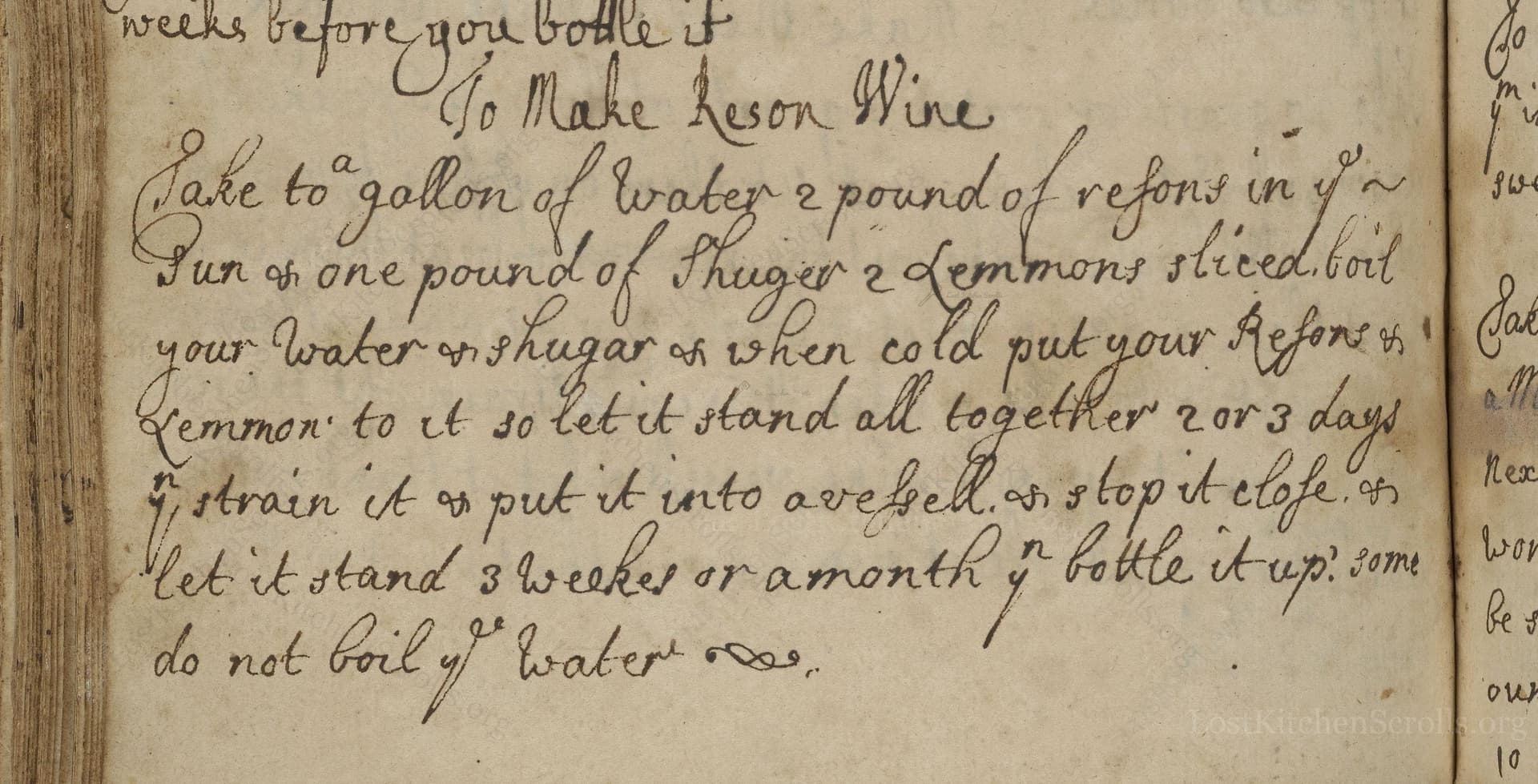To Make Reson Wine
From the treasured pages of Cook-book of Margaret Turner
Written by Margaret Eyre

To Make Reson Wine
"Take to a gallon of water 2 pound of resons in ye sun & one pound of shuger 2 Lemmons sliced. boil your water & shuger & when cold put your Resons & Lemmon to it so let it stand all together 2 or 3 days & strain it & put it into a vessell. & stop it close. & let it stand 3 weeks or a month &n bottle it up; some do not boil ye water."
Note on the Original Text
This recipe uses early 18th-century English spelling—‘resons’ for ‘raisins’, ‘shuger’ for ‘sugar’, and ‘lemmons’ for ‘lemons’—as well as period punctuation and phrasing with minimal instruction or measured times. Directions are brief and assume familiarity with basic brewing techniques common to the era’s readers. The lack of step-by-step technical detail reflects both the oral tradition of cookery and an expectation of experienced household management.

Title
Cook-book of Margaret Turner (1709)
You can also click the book image above to peruse the original tome
Writer
Margaret Eyre
Era
1709
Publisher
Unknown
Background
Step into the refined world of early 18th-century cookery with Margaret Eyre, where recipes are whispered secrets and culinary wonders await. From hearty roasts to delicate sweets, this charming tome serves up inspiration fit for the tables of historic England.
Kindly made available by
Folger Shakespeare Library
This recipe comes from the early 18th-century English household of Margaret Eyre, around 1709—a time when home wine- and cordial-making flourished as both a domestic craft and a necessity. Wine from raisins (sometimes spelled ‘resons’ or ‘raisins’) offered a way for families without access to vineyards to create their own festive beverages. Recipes such as these are found in many English household manuscripts of the period, reflecting the importance of using imported dried fruits and citrus for preserving and flavoring.

In Margaret Eyre’s kitchen, boiling water would be achieved in a large cauldron or pot over the hearth, with sugar and water stirred with a wooden spoon. After infusing the raisins and lemons, the mixture would be strained through cloth or a fine sieve. A stoneware fermenting crock or cask, stopped with a cloth or wooden bung, provided the vessel for fermentation. Bottling would use glass bottles sealed with corks or wax where available.
Prep Time
20 mins
Cook Time
0 mins
Servings
10
We've done our best to adapt this historical recipe for modern kitchens, but some details may still need refinement. We warmly welcome feedback from fellow cooks and culinary historians — your insights support the entire community!
Ingredients
- 1 gallon water
- 2 pounds sun-dried raisins (substitute: standard seedless raisins if sun-dried unavailable)
- 1 pound granulated sugar
- 2 lemons, thinly sliced
Instructions
- To make a modern version of Reson Wine, start by boiling 1 gallon (3.8 liters) of water and dissolving 1 pound (2 cups) of granulated sugar into it.
- Once cooled to room temperature, add 2 pounds (about 2 quarts) of sun-dried raisins and 2 lemons thinly sliced.
- Let this mixture stand, covered, at room temperature for 2-3 days to infuse.
- Afterward, strain out the solids and pour the liquid into a clean fermentation vessel, securing it with an airlock or tightly-fitting lid.
- Allow this to ferment at room temperature for 3 to 4 weeks.
- Once fermentation appears to have ceased, decant into clean bottles and seal.
- Optionally, you can skip boiling the water for a more rustic approach, as suggested in the original recipe.
Estimated Calories
130 per serving
Cooking Estimates
It takes about 20 minutes to prepare the ingredients and start simmering the mixture. There is no real cooking time beyond dissolving the sugar in hot water. Each serving has around 130 calories. The recipe makes about 10 servings, based on standard wine serving sizes.
As noted above, we have made our best effort to translate and adapt this historical recipe for modern kitchens, taking into account ingredients nowadays, cooking techniques, measurements, and so on. However, historical recipes often contain assumptions that require interpretation.
We'd love for anyone to help improve these adaptations. Community contributions are highly welcome. If you have suggestions, corrections, or cooking tips based on your experience with this recipe, please share them below.
Join the Discussion
Rate This Recipe
Dietary Preference
Main Ingredients

Den Bockfisch In Einer Fleisch Suppen Zu Kochen
This recipe hails from a German manuscript cookbook compiled in 1696, a time whe...

Die Grieß Nudlen Zumachen
This recipe comes from a rather mysterious manuscript cookbook, penned anonymous...

Ein Boudain
This recipe comes from an anonymous German-language manuscript cookbook from 169...

Ein Gesaltzen Citroni
This recipe, dating from 1696, comes from an extensive anonymous German cookbook...
Browse our complete collection of time-honored recipes



